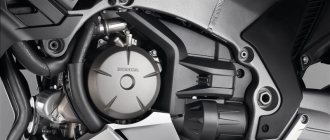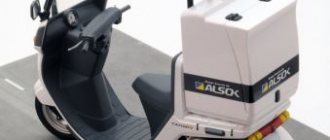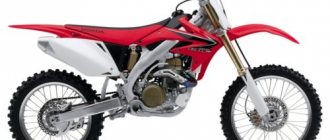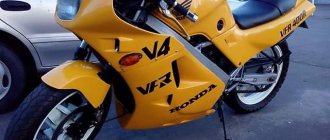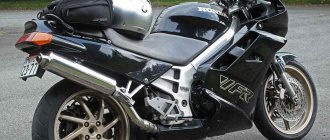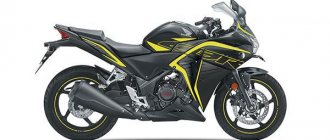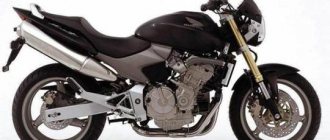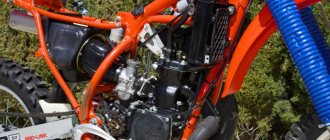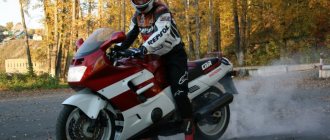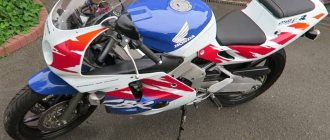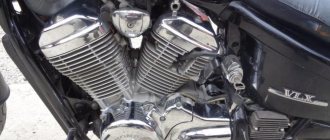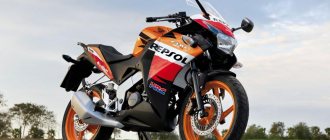We had the opportunity to try out the new Honda VFR 1200 F. It is equipped with a dual clutch gearbox. The puppy falls to the ground.
Honda VFR 1200 F
Sometimes it pays to look beyond the tip of your nose and see what's going on outside your own backyard. This is the experience that Honda shared with selected journalists by inviting them to Japan for a test session of the new VFR 1200 F, which took place at the Sugo Raceway. The biggest sensation was the dual-clutch automatic transmission of this motorcycle.
Let's start with the VFR 1200, which shifts gears normally and would give a new kick to guys who love supersports. A compact V4 engine and a design that easily draws European inspiration are evidence that the VFR 1200 follows in the footsteps of the VFR 800 and 1100 XX. But Honda still raises the bar, which is clearly evident in the ergonomics: the machine has a narrow waist, the saddle height remains at a reasonable level, and the padding will not allow the rider to complain about the lack of comfort. In short, long-legged bikers will appreciate the one size fits al principle.
The clutch operates easily and the lever doesn't require a clutch, the throttle turns without resistance, the gears shift smoothly and precisely - it's like nothing else, but that's the point. For this purpose there is a V4 engine that operates vibration-free in all speed ranges. It doesn't have the scalp-your-head shock of the K-series Beemers, it pulls fairly softly and doesn't overwhelm the rider's attention. However, the gentle nature hides the real monster hidden in this bike: Honda claims 116 Nm from just 4000 rpm, which is 90% of the maximum torque. If this is true, then... But let's wait for the first measurements.
Honda VFR 1200 F 116 Nm already at 4000 rpm, or 90% of max.
001_MOTO_0210
HONDA VFR1200F, sport-tourist, 2010, 1237, cm3, 172 hp.
267 kg, price not determined. HONDA VFR1200F, sport-tourist, 2010, 1237, cm3, 172 hp. 267 kg, price not determined.
For two years, Honda fed the motorcycle world with scant scraps of information about the new “vyfer”, warming up the public, and finally, journalists were given the opportunity to get up close and personal with the new device.
Its purpose is to combine excellent directional stability, a bottomless traction reserve and a high level of comfort of a “mainline locomotive”, which Drozd was, with the lightness, compactness, efficiency and excellent controllability of such a device as the VFR800, capable of serving not only as a “tourist”, but also and a city motorcycle for every day.
Agree, it’s a difficult compromise to achieve! So I experienced some skepticism during the pre-test presentation. But it is precisely this combination that Honda is focusing on in positioning the new device. This is not just a sport-tourist, it is a road-sport, that is, road-sports. As planned, it should be equally good on the highway, in the hustle and bustle of the city, and even on the race track (of course, in “entertainment” mode). If everything is more or less clear with the “long-range”, then how will 267 kg of curb weight behave in the city, and even more so on the track? Advertising statements from manufacturers often turn out to be overly colorful, so the question of faith itself flowed into an experimental channel: “I’ll try and find out what kind of “elephant” this is, capable of performing the dance of little swans.”
RELAXED EMBRYO . The morning of the test day greeted us with a light haze and seven degrees of heat. Twelve test bikes warm up in a parking lot. The low, guttural sound is similar to that produced by a squadron of heavy bombers. The sound of the V4 is pleasant in itself, and then there are the rear crankpins of the crankshaft rotated by 28° relative to the front ones (the cylinders work in the order 1-2-4-3 with intervals of 256°-104°-256°-104°) - in a word , at a glance you can’t tell how many “pots” are under the plastic. The effect is completely indescribable.
The first impressions of the “workplace” are very pleasant. In the “sub-loin” part, the saddle is quite wide and bucket-shaped, and closer to the tank it narrows noticeably. Compared to the saddle of the previous “vyfer”, this is almost a third narrower. The “waist” of the motorcycle is generally unnaturally narrow for a device with an engine of this size. This was achieved due to the non-standard layout of the engine: the cylinders are not arranged in the usual checkerboard pattern, but asymmetrically: the rear “pots” are as close as possible, and the front ones are placed at the edges (for more details, see “Moto”, No. 12–2009). Quite deep recesses under the knees in the gas tank greatly complement the picture. If you get on a motorcycle with your eyes closed, you could easily confuse it with some very sporty 600. Thanks to the already mentioned narrowness and low saddle, even people below average height can firmly rest both feet on the asphalt. The line of accessories also includes a lowered saddle, so that the height of the “vyfer” is accessible to almost everyone. I was also surprised that the saddle allows you to move the body a good ten centimeters back and forth, so that even two-meter pilots can comfortably “lie down on the tank” and not knock the helmet visor against the windshield. In a word, you can safely sculpt a baseball cap label on the VFR - “one size fits all” - one size for everyone.
At one time, the “Eight Hundred” was very much loved by “truck drivers” for its comfortable seating position, quite relaxed and straight, and at the same time sporty. This was largely achieved thanks to high clip-ons and fairly low footrests. In pursuit of comfort, they were even installed on Drozdys in order to straighten the back and take some of the load off the wrists.
But on the “two hundred liter” the clip-ons were made quite low, so that the tilt of the body turned out to be noticeably greater than on its predecessor, and the footrests, on the contrary, were installed a little higher. The knees, of course, do not cover the ears, but at first the landing did not seem relaxed. Looking ahead, I note that after almost four hundred kilometers walked in a day, my wrists did not hurt, my back did not ache that it wanted to straighten, and only my knees slightly buzzed from being in a bent state for a long time (although, perhaps, this is because that someone's legs are too long).
In a word, Japanese engineers managed to create a very successful compromise between the relaxed fit of large “tourists” and the composure of tough “sports”.
A test of patience
Honda VFR 1200 F
Those who are eager to get their hands on this bike will have to wait a little longer, because the DCT version will not appear until the summer of 2010.
“First stop after 300 km,” says Yosuke Hasegawa, project manager of the VFR 1200 F. “Was the Honda VFR 1200 intended as a sports bike or rather as a tourer? Our goal was to create a dynamic sports bike with a V4 engine, suitable for everyday use as well as touring and long rides. We were guided by the motto “first stop after 300 kilometers.”
At 6000 rpm the engine gets a huge kick, especially in second gear. This was the intention, and these capabilities are provided by the ride-by-wire system. Depending on various parameters, such as the current gear ratio, valve setting or speed, different values for ignition and injection are set.
The VFR 1200 has a lot of interesting technical goodies, but not a lot of electronics - no traction control, no choice of ignition characteristics, etc. This is true, but we decided that they would not be in this model because it would change the character of the bike "
Who is this motorcycle for, i.e. who will benefit primarily from the dual-clutch automatic transmission? I think all riders, regardless of their level of experience, will get a huge dose of sporting excitement thanks to DCT. This gearbox is important! – easy to use and allows direct power transfer.
Post Views: 3,389
002_MOTO_0210
Deep recesses under the knees in the gas tank.
Deep recesses under the knees in the gas tank.
MATTER OF HABIT. Another surprise: Honda has revealed new steering wheel switches! It’s not that I really didn’t like the old ones (yes, the same ones that were installed on the CB750, CBR1000F and other “dinosaurs”), they were comfortable and did not break, but moral age is sometimes no less important than physical age. Exaggeratedly large keys and switches with smooth shapes and pleasant colors look like toys for infants who need to train fine motor skills of their fingers and learn colors. This logic is not difficult to understand: it’s easier to “hit” large keys blindly and with gloves on; but, in my opinion, the designers still overdid it. For example, I’m used to holding the steering wheel closer to the edges of the handles, but to turn on the left turn signal, I have to move my hand close to the remote control, otherwise my thumb simply does not reach the left edge of the key. Considering that my hands are very raking, those with shorter fingers will find it completely uncomfortable. True, this is perhaps the only “jamb” noticed with the new remote controls.
Preface
I got to Honda's Winning Technology Tour only the second time.
I first signed up at 's-Hertogenbosch, but since I didn't receive any confirmation, I decided it wasn't working out and made other plans for the weekend. They finally called me the day before the event, but it was too late to change anything. So I looked at where else the demos were taking place and re-registered with Breda. At the same time, I had to persuade my family in connection with shirking direct “papal” duties, but in the end I received “permission” and confirmed my participation. It turned out that there were many more applicants than there were places, i.e. Ideally it was worth it :). Initially, the desire was not so much to try the new DCT box as to try the VFR1200X :), but in the end, I re-read a large number of reviews and had already lowered my expectations in advance, giving the virtual “palm” to the Yamaha Super Tenere. So, the long-awaited day came and I went to Motoport Breda to try the new version of Honda products, which, according to the manufacturer, are the future of motorcycle manufacturing.
003_MOTO_0210
After years of conservatism, Honda has finally updated the design of the steering wheel switches.
The keys have become larger and more comfortable. After years of conservatism, Honda has finally updated the design of the steering wheel switches. The keys have become larger and more comfortable.
Having come to their senses from many years of sleep, Honda ergonomists finally realized that those buttons that are used more often should be located in the immediate vicinity of the thumb, while occasional ones, such as the sound signal, can be placed further away. And in the new design, the turn signal switch and the buzzer have been swapped. In general, it is logical and, most importantly, really convenient when, turning to the turn signal toggle switch, you don’t have to “stick” your finger down, but the great force of habit more than once or twice forced the journalistic peleton to beep in unison before turns, instead of turning on the turn indicators. The feature is convenient, but you need to get used to it.
conclusions
“Vifers”, oddly enough, did not impress me. Especially automatic. Great as an experience, would you buy it? No! To one degree or another, motorcycles were out of my comfort zone and “fan”. Ideologically small Hondas like the NC750X can be quite a good option for every day for relaxed driving, but provided that there is a “real” motorcycle in the garage :). In principle, this topic popped up in almost everyone’s mind, except perhaps the young lady who was completely captivated by the NC750S.
On the way back home, at some point I realized that my “Sibiha” was simple and relaxed, without a pig’s squeal, but it constantly continued to please me. This is the case when an old horse does not spoil the furrow and does everything as it should. After practicing upshifting without a clutch, gear shifting generally became soft and fluffy.
Maybe we should just take the new CBF1000 model with panniers and calm down with the choice of the “ideal horse”? 
Share link:
- Click here to share content on Facebook. (Opens in a new window)
- Click to share on Twitter (Opens in new window)
- Click to share on Pinterest (Opens in new window)
- Click to share posts on Tumblr (Opens in new window)
- Click to share on LinkedIn (Opens in new window)
- Send this to a friend (Opens in new window)
004_MOTO_0210
The turn signal switch has swapped places with the horn button.
This decision is dictated by ergonomics: under the finger is what is used most often. Although at first it’s not very familiar. The turn signal switch has swapped places with the horn button. This decision is dictated by ergonomics: under the finger is what is used most often. Although at first it’s not very familiar.
Unlike remote controls, the new dashboard does not raise any questions. Worked perfectly in all respects. The traditional VFR family layout with an analog tachometer in the center and two LCD displays on the edges is perfectly readable in any light. The entire left display is given over to a digital speedometer and fuel gauge, and on the right there is a bunch of all kinds of information: the temperature of the coolant, the “outboard” air, a clock, an odometer, two daily mileage counters, the number of the selected gear... True, the fuel flow meter promised in the press release, I could not find it, although such a function is sometimes vital for a “long-range” device.
While I was studying the ergonomic features and instrument buttons, the first hundred kilometers flew by on a fairly busy highway. Surprisingly invisible. Contrary to fears, the landing, which at first seemed rather tense, turned out to be comfortable.
005_MOTO_0210
HONDA VFR1200F
HONDA VFR1200F
IMPORTANT LIGHT. We arrived at the beginning of the mountain serpentine, and the leader gave Fr. For the next fifty kilometers of smooth asphalt, continuous turns and indescribable mountain beauty, everyone is free to drive as they want. I open the gas and go into a tight spiral of serpentine. The engine amazes with the amount of thrust hidden in it. VFR, forgive the cliche, is most reminiscent of a steam locomotive in character. Acceleration is powerful and smooth throughout the entire rev range, except at the very bottom. This characteristic of the engine will certainly be appreciated by most motorcyclists, especially on long-distance bikes, where excessive sharpness of reactions only irritates. The only “pickup” occurs around 5500 rpm, when the power valve in the exhaust system is activated, but it is so faintly expressed that if the gas is less than half open at the moment the system is activated, it is completely unnoticeable. You feel unexpectedly confident and safe: I expected a more temperamental character from the “two hundred liter”.
In a quiet driving mode, the linear characteristic of the engine without pick-ups and “holes” allows you to almost completely forget about gear shifts. Know, turn the throttle. 90% of the torque (that is, 116 Nm) of the maximum 129 Nm is available already at 4000 rpm, so if you don’t “burn”, you can get by with just one gear for a fairly wide speed range. True, at low and medium speeds the engine responds to the pilot’s commands with some laziness. Environmental clamps make themselves felt, and the settings of the “electronic” throttle grip were probably selected primarily with the expectation of “not scaring” the driver with excessive twitchiness of the car and making control as comfortable as possible.
If you want to shoot, you will have to keep the tachometer needle above that same 5500 rpm. The linearity of power delivery is the same here, but the engine's responsiveness is noticeably better. You don’t have to wait for the thoughtful reaction of fast electronics to the throttle.
Despite the fairly decent weight, the motorcycle steers well. This is where those, at first glance, useless features on a “tourist” appear: a seat with a fairly strong tilt of the body and a narrow saddle. Of course, the nimbleness of the “six hundred” (and even a liter sportbike) is a step away from Beijing, but in comparison with its classmates, be it the Kawasaki 1400GTR or the Yamaha FJR1300, this Honda is simply ideal! It was here that Honda’s bold statements about handling at the pre-test presentation were confirmed. We can say that the new “vyfer” is the first of the entire sports tour to reach the level set not so long ago by the BMW K1300GT. The Germans were indeed ahead in this matter, but Honda does not leave the leader a chance to rest on his laurels in splendid isolation.
On a mountain road, twisted worse than other roller coasters, the “vyfer” gives amazing emotions. In the blink of an eye, he turns from that same “locomotive” that only knows how to “fly forward” into a rather obedient and flexible conic. The motorcycle effortlessly shifts from knee to knee in turns, without making the pilot sweat.
There is plenty of chassis rigidity here. The motorcycle perfectly maintains its trajectory even at maximum lean angles, even to the point where the anchors of the pegs strike the asphalt. Moreover, if not for the footpegs, the motorcycle could have been laid even lower. The chassis and tire profile allow this (and I complained about the excessively raised pegs! They should be raised!). The suspensions, although they are quite meager in adjustments (only spring preload and rebound hydraulics both front and rear), but both the front “upside-down” and the rear Pro-Link system with a monoshock absorber, traditionally installed for the family on a cantilever pendulum, cope quite calmly with critical loads in corners.
Magic trick with mass
From what you could feel, the biggest kick occurs at 6000 rpm. Especially in second gear, the Unicam-head V4 rips so hard that the Dunlop Roadsmart rear end leaves black marks on the asphalt and the bike wobbles backwards, causing the euphoria of bikers who like to ride hard. There are no electronic gadgets to spoil the fun. Honda engineers said that they deliberately chose this characteristic so that in the lower rev range the engine behaves like a meek lamb, but in the upper rev range it lets loose. Fun performance has a tradition: in the VFR-e 800 this task was accomplished with V-Tec valve control.
006_MOTO_0210
The motorcycle holds its trajectory perfectly.
The motorcycle holds its trajectory perfectly.
In the suspension settings, that golden mean has been found, allowing you to feel quite comfortable on the not very high-quality asphalt of local roads (of which we have all of Russia), but also to really “go all out”, and not only in a straight line. Some may complain about the lack of full adjustments, but if you remember that the VFR is a sports-touring machine, it doesn’t need it - the principle of reasonable sufficiency is in action.
But with the brakes, the designers apparently decided to adhere to the opposite principle - unreasonable redundancy. The brakes have such a reserve that they would be enough even at speeds of “over three hundred”, if the motorcycle was capable of this. Throughout the entire test route, even when driving in "all money" mode, I controlled the brake lever with two fingers. More is not required. The combined brake system partially applies the rear brake when the lever is pressed, so I used the pedal only because the tester was obligated to press everything that was pressed. Most likely, future owners of “vyfers” will have to remember the pedal under their right foot very rarely (only in the case of very force majeure circumstances).
Dimensions and weight
It’s interesting that installing a robotic gearbox changed the weight by only 10 kg:
- Curb weight without robot (on mechanics) - 275 kg .
- Curb weight with automatic transmission - 285 kg .
The overall dimensions changed only once, when the manufacturer decided to offer the bike in Japanese markets. The changes affected the height of the saddle and, accordingly, the ground clearance. Thus, even when casting the frame, it was known where the motorcycle would go from the factory.
- 2285 mm - length;
- 915 - width;
- 1335 — in height (according to mirrors);
- Wheelbase - 1595 mm.
Seat height:
- for the Japanese version - 810 mm;
- for all others - 850 mm.
The clearance of the Japanese version is 165 mm, the rest - 180 mm.
007_MOTO_0210
The six-piston, four-pad calipers have excellent potential, but are not intimidatingly harsh.
The slowdown is always predictable and absolutely controllable. The six-piston, four-pad calipers have excellent potential, but are not intimidatingly harsh. The slowdown is always predictable and absolutely controllable.
There is nothing to say about the Honda ABS system - even if the army of defenders of the “pure style” of braking systems is large, I dare to report that a heavy and fast car without this system is the same as a Harley without chrome: it occurs in life, but it looks ridiculous .
Surely, for many, like for me, the most pressing issue is the cardan drive. The very fact that Honda has finally made a “sport tourer” “on a cardan” is already a kind of small revolution. Although it is impossible to call the transmission “cardan” in the full sense of the word. On the engine side, the shaft is mounted precisely on the cardan joint, but the wheel has a CV joint instead. The wheel has a constant rigid connection with the power unit, and even with a sharp release of gas there is not the slightest noise, much less shock. Actually, Honda has long been famous for its shaft-drive motorcycles, from the NV750 and SuperMagna to the GoldWing and Fury, but it’s still unusual to see a driveshaft on a Honda sports tourer. That's why I was wary at first. It turned out in vain.
And knowing with what reverent feelings domestic motorcyclists treat the “eternal” shaft, I will assume that many VFR1200Fs will be purchased in Russia precisely thanks to the presence of this magical unit.
Competitors
When asked about the competitors of the developers, in addition to Super Tenere from Yamaha, they also name the German goose - BMW R1200GS and the Japanese Versys 1000 from Kawasaki.
BMW R1200GS.
Kawasaki Versys 1000.
Users answer the question about competitors like this:
- crosstourer is better than super tenere in terms of fuel consumption and ergonomics;
- it is better than the German in terms of weight and driving performance;
- better than the ducati multistrada 1200 because it rarely breaks;
- and finally, Kawasaki is better because it’s Honda.
008_MOTO_0210
The turn signals in the mirrors are a familiar feature, but the bright LED side lights are new.
With them, the VFR is recognizable even in pitch darkness. The turn signals in the mirrors are a familiar feature, but the bright LED side lights are new. With them, the VFR is recognizable even in pitch darkness.
WITH A CUP OF COFFEE ON THE "DOVSHKA". The mountain serpentine led us onto the highway. After the dizzying turns, we moved on to researching the speed characteristics of the experimental motorcycles. “Vyfer” with slight laziness reaches the required 250 km/h (although the speedometer shows all 270, but we know where the truth is!). At this speed, it is clearly felt that the engine’s capabilities are far from being exhausted, both in terms of traction and speed (and if the first is quite subjective, then the second is an objective fact), but alas, the legislation imposes very specific restrictions, even if you are a Honda , even Lexus. The behavior of the motorcycle at speeds close to maximum was a pleasant surprise. The rather soft (by sporting standards) suspension behaves excellently; the motorcycle does not float or yaw, maintaining reliable contact with the road surface even on asphalt defects. The motorcycle is generally very stable, even after the “kopeck piece”. The new two-layer plastic also works for the same purpose, also acting as a stabilizer, using the flow of oncoming air as a support. So, the higher the speed, the more stable the motorcycle is on the road.
By the way, the aerodynamics here are also in perfect order, and such that many should learn. Even at maximum speed, and even I, who was not short at all, did not have to scratch the gas tank with the chin of my helmet: I only had to bend down to completely fall into the aerodynamic shadow of the windshield. What can we say about “civilian” speeds - at them you don’t have to lower the visor at all. There’s almost no wind in your face anyway, and if you install an additional piece of glass from the list of accessories, you can completely forget about flies on your teeth and dust in your eyes.
009_MOTO_0210
The saddlebags are also unlocked with the ignition key.
The saddlebags are also unlocked with the ignition key.
FIGHT OF TWO EGOS. The test run ended after dark. We spent more than eight hours in the saddle and traveled almost four hundred kilometers. Wide high-speed passes on the autobahn, tight spirals of serpentines, narrow local paths, city streets - I had a chance to try almost every conceivable mode for a road motorcycle. The whole day spent in the saddle of the VFR1200 did not tire me one bit; on the contrary, I wanted to ride more and more, despite the temperature dropping almost to zero and the rain falling. The wizards from Honda really managed to create a completely new motorcycle, unlike any existing one and endowed with a completely unique set of qualities. Two definitions of this motorcycle, very similar in meaning, but very different in emotional coloring, are fighting within me.
Driving characteristics, fuel consumption
The motorcycle feels confident on winding roads, taking tight turns with confidence and predictability.
Despite the reduced power, the maximum speed indicated in the documents for the motorcycle is 200 km/h . According to users, this speed can be achieved with fully loaded cases and a second number (if you want to lose the first or second). We managed to accelerate a clean bike on a good autobahn to 235 km/h .
Fuel consumption
Fuel consumption is modest (by class standards). For 100 km, a fully functional bike at cruising speed ( ~150 km/h ) will require only 5.5 liters .
Acceleration to hundreds
The acceleration of up to 100 km indicated in the documents will allow you to compete with many sports - 4 seconds.
010_MOTO_0210
The test was organized by Honda Motor Rus, equipment was provided by the Moto.Ru store.
The test was organized by Honda Motor Rus, equipment was provided by the Moto.Ru store.
An old lazy person and a sybarite insists that the Vifer is an excellent device, capable of delivering a lot of pleasure from driving both on city streets and in long-distance driving thanks to its comfortable seating position, flexible engine, comfortable suspension, heaps of additional equipment and, in general, amazing friendliness to the pilot. .
At the same time, a boring and corrosive test pilot, not yet completely crushed by a lazy person, grumbles that the motorcycle is good, but only the “two hundred liter” is in any case not intended for beginners, and therefore could have been angrier, especially on “at the top”, otherwise it’s not an engine, but some kind of boring felt boots, especially considering the claims to sportiness... It’s probably good that the test drive didn’t have a track part. Then the boring bullet-shooter would definitely overpower the truck-driver contemplating the surrounding landscapes.
Well, if you didn’t overpower it, it turns out that the VFR1200F is an exceptionally worthy descendant of its crowned ancestors, and it is very likely that in a few years it will take an equally honorable place among the ceremonial portraits in the hall of fame. Although the shooter in me will still hope and believe that if a “vyfer” with the letter “F” at the end was born, then his brother with the letter “R” must someday appear too...
